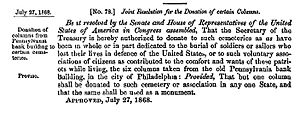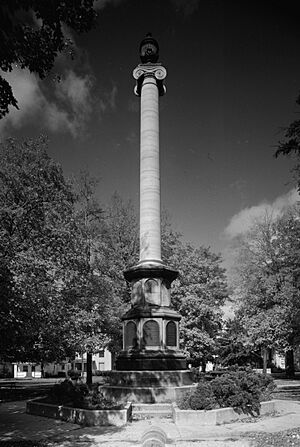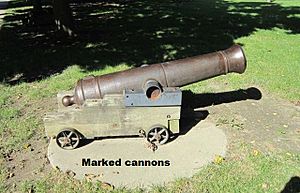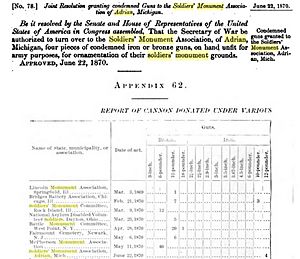Civil War Memorial (Adrian, Michigan) facts for kids
|
Civil War Memorial
|
|
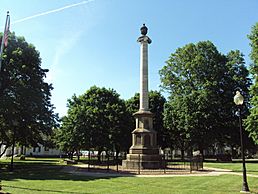 |
|
| Location | Monument Park Adrian, Michigan |
|---|---|
| Built | July 4, 1870 |
| Architect | Benjamin Latrobe |
| NRHP reference No. | 72000632 |
Quick facts for kids Significant dates |
|
| Added to NRHP | June 29, 1972 |
The Civil War Memorial is a special marble monument. You can find it in the middle of Memorial Park in Adrian, Michigan. This monument remembers soldiers from Adrian who died in the American Civil War (1861–1865).
It was officially named a Michigan Historic Site on August 13, 1971. Later, it was added to the National Register of Historic Places on June 29, 1972. The monument was first shown to the public on July 4, 1870.
Contents
History of the Monument
The Civil War Memorial connects Adrian, Michigan, with Philadelphia, Pennsylvania. This is because the main column of the monument came from Philadelphia. It was one of six marble columns on the front of the old Bank of Pennsylvania building. This bank building and its columns were built way back in 1799.
The Bank of Pennsylvania building was very important. It was one of the first buildings in the United States to use the Greek Revival architecture style. This style looks like ancient Greek temples. In 1867, the bank building was taken down.
After the building was demolished, one of its columns was saved. With special permission from the United States Congress, this column was given to Adrian. The Hon. F.C. Beeaman, a member of Congress and former Mayor of Adrian, helped get the column. J. Fred Myers Esq. also helped. Hon. Hugh McCulloch, who was the Secretary of the Treasury, donated it. This column is one of the only parts of the original Bank of Pennsylvania building still in Michigan. Another column from the bank is in Wilmington, Delaware.
Design of the Memorial
The original design for the column was made by architect Benjamin H. Latrobe for the Pennsylvania Bank. For the monument in Adrian, Francis R. Stebbins of Adrian was the architect. The column was given to the monument group by a special act of Congress in 1868.
The monument also includes a sandstone base and an urn at the top. These parts cost $10,000. This money was collected by the Adrian Soldiers’ Monument Association. The monument was officially revealed in Monument Park on July 4, 1870. It was the second monument built in Lenawee County to remember Civil War soldiers. The first was a cemetery monument in nearby Franklin Township.
The large column stands on an eight-sided sandstone base. Each side of the base has a bronze tablet. These tablets list the names of 84 soldiers who died. They also show which army group (regiment) each soldier belonged to. On top of the column is a sandstone urn.
The base of the monument has a special message carved into it. It says:
-
-
-
- "1870. Erected by citizens of Adrian in memory of our fallen soldiers. By such as these was our Union saved in the great struggle of 1861–1865."
-
-
Cannons at the Monument
Four cannons stand around the Civil War Monument. Two of these cannons do not have clear markings about where they were made. The other two cannons are well-known and have markings. They were made in 1834 at the Columbia Foundry. This foundry was in Georgetown, which is now part of Washington, D.C.
These cannons have "US" marked on the top. This shows they belonged to the United States. Their weight is marked at the back. The letters "WJW" are also on the top. These letters stand for Colonel William Jenkins Worth. He was the person who checked cannons from all the foundries in the D.C. area at that time. At the bottom front of the cannons, one is marked "#2" and the other is "#3." These were special test cannons, and only three were ever made. No one knows where cannon #1 is today.
The cannons were also given to the Adrian Monument Association by an act of Congress. This happened on June 22, 1870. The Hon. F.C. Beeaman, J. Fred Myers Esq., and Henry Hart, the association president, helped get these cannons for the memorial.
See also
 In Spanish: Monumento conmemorativo de la Guerra Civil (Adrian) para niños
In Spanish: Monumento conmemorativo de la Guerra Civil (Adrian) para niños
Images for kids





